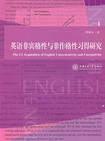英语非宾格性与非作格性习得研究
出版时间:2011-12 出版社:上海交通大学出版社 作者:李素枝 页数:179
内容概要
本书在生成语法框架下考察中国英语学习者对英语不及物动词的习得,旨在发现英语非宾格动词与非作格动词在二语习得者心理语法中的知识表征,二语习得者有关英语非宾格性与非作格性知识的发展模式,以及普遍语法在论元结构习得中的作用。本书对论元结构习得的研究是目前该领域的研究热点之一。
本书可供高等院校语言学专业的研究生、教师和二语习得研究者阅读参考。
书籍目录
Chapter 1 Introduction
1.1 Research Background
1.2 Research Objectives and Research Questions
1.3 Significance of the Study
1.4 Organization of the Book
Chapter 2 Theoretical Analysis of the Split Intransitivity
2.0 Introduction
2.1 The Split Intransitivity
2.2 The Split Intransitivity Hierarchy
2.3 Split Intransitivity in English and Chinese
2.4 Unaccusative Diagnostics in English and Chinese
2.5 Summary
Chapter 3 Previous Studies on L2 Intransitivity
3.0 Introduction
3.1 Early Studies Based on Spontaneous Composition Data
3.2 Studies Based on Corpus Production Data
3.3 Studies Based on Experimental Data
3.4 Summary and Unresolved Problems
Chapter 4 Research Methodology
4.0 Introduction
4.1 Research Hypotheses
4.2 Subjects
4.3 Tasks and Materials
4.4 Data Collection
4.5 Procedures for Data Analysis
Chapter 5 Results
5.0 Introduction
5.1 Results for Hypothesis I
5.2 Results for Hypothesis II
5.3 Results for Hypothesis III
5.4 Further Analysis of the Results for Hypothesis IV
5.5 Summary of the Overall Results
Chapter 6 Discussions
6.0 Introduction
6.1 Summary of the Major Results
6.2 L2 Mental Grammar. Unaccusative- Unergative Distinction
6.3 Sensitivity to the Semantic Hierarchy
6.4 The Developmental Patterns
6.5 The Role of UG and L1
Chapter 7 Conclusions
7.0 Introduction
7.1 Summary of the Major Findings
7.2 Implications
7.3 Limitations and Recommendations
Appendix
References
章节摘录
The present study has probed into the knowledge of split intransitivity in Chinese EFL learners mental grammars. One of the goals is to test whether the learners are sensitive to the abstract properties of argument structure when they are constructing their English grammars. To achieve this goal, two approaches have been adopted. One is through the investigation of the learners' acquisition of the subject-verb order, the other through the examination of the learners sensitivity to the syntactic unaccusative diagnostics. The results of these two aspects will be analyzed and iscussed respectively in this section. 6.2.1 Subject-Verb Order; Unaccusatives vs Unergatives The results from the WEPT have revealed that a significant difference exists in the rate of overpassivization between the unaccusatives and the unergatives. Learners at low and intermediate levels tend to commit passivized unaccusative errors about twice as many as those passivized unergatives (11, 5% vs 5.8% for the low-proficiency learners, 8. 6% vs 4. 3% for the intermediate group) , and the advanced learners only make 0. 3% overpassivization errors with the unergative verbs in contrast t0 3. 0% with the unaccusatives. The tendency is also true of the grammaticality judgment task, wherein the learners accept the correct intransitive constructions and reject the incorrect passivized forms with the nergatives much more strongly than with the unaccusatives. The results indicate that the learners differentiate the unaccusatives from the unergatives in their mental grammars, and that the passivized unergative errors are unlearned earlier than the unaccuative equivalents. It might be inferred from the findings that L2 learners are aware of the divergence at the level of argument structure representations between the unaccusatives and the unergatives. Otherwise, it would be hard to explain the learners differentiation between the two types of verbs in their performance both on the intransitive constructions and the unaccusative diagnostics. Since the unaccusatives and the unergatives appear in the same sentence structure of subject-verb order at S-structure, but differ in heir argument structure representations. ……
图书封面
评论、评分、阅读与下载
用户评论 (总计0条)
相关图书
- 语言迁移研究新视角
- 英语四级词汇随身记
- 机械设计课程设计
- 大学英语四级词汇 搭配+活用
- 初中英语语法精讲与精练
- 全优考评·金牌课课练
- 教材金练 历史(上海版)
- 教材金练 语文(上海版)
- 教材金练 数学 一年级第二学期/1年级下(书+卷)
- 教材金练 数学(5年级/下)
- 教材金练 语文 一年级第二学期/1年级下(书+卷)
- 草书滕王阁序
- 王羲之《十七帖》汇考
- 篆书滕王阁序
- 书法》百强榜精英丛帖·章草《滕王阁序
- 能源与电力分析年度报告系列 2011 中国节能节电分析报告
- 农网配电生产人员技能培训教材
- 能源与电力分析年度报告系列 2011 世界500强电力企业比较分析报告
- 房地产中介经纪人实战手册
- 特高压直流控制保护系统配置及现场运行
- 县级电网无功优化补偿建设与管理
- 大型发电机转子故障分析与诊断
- 普通高等教育“十二五”规划教材
- ±800kV直流换流站运行技术(上、下册)
- 威客英雄
